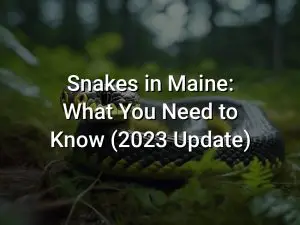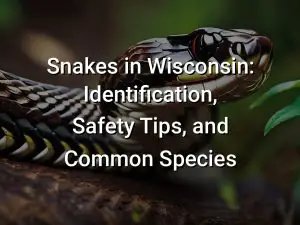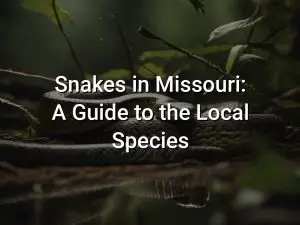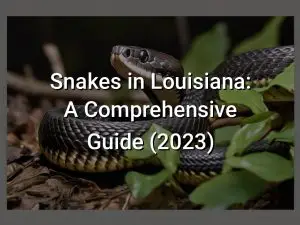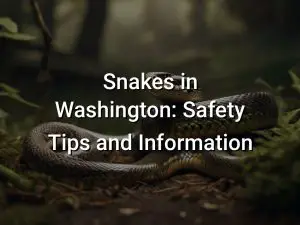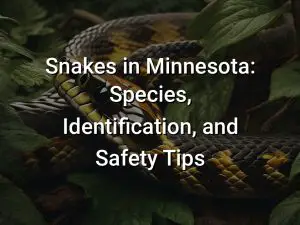Snakes in Nebraska: Common Species and Safety Tips
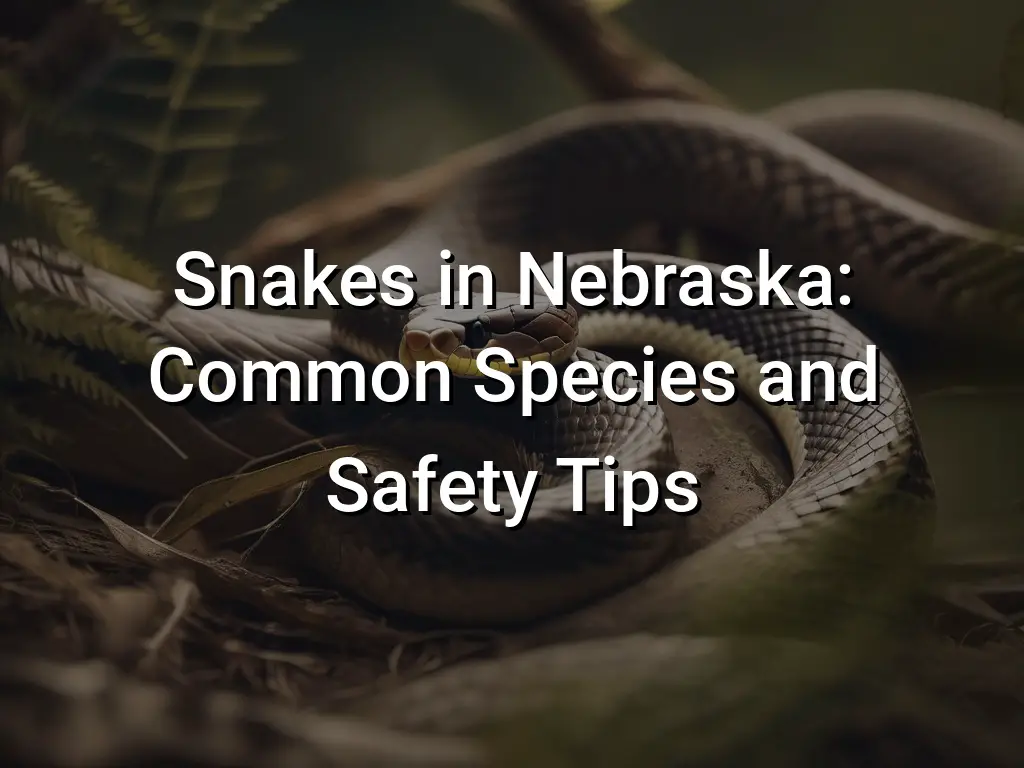
Nebraska may not be the first place that comes to mind when you think of snakes, but the state is actually home to a wide variety of snake species. From the harmless Garter Snake to the venomous Prairie Rattlesnake, these slithering creatures play an important role in Nebraska’s ecosystem.
In this article, we’ll take a closer look at some of the common snake species found in Nebraska and provide safety tips to help you coexist peacefully with these fascinating reptiles. So join us on this snake-filled adventure and learn more about the snakes of Nebraska!
Quick Links
Garter Snakes
Garter snakes are one of the most common snake species in Nebraska. They are non-venomous and typically have a length of 18 to 26 inches, although some individuals can grow up to 48 inches long. Garter snakes are known for their distinctive pattern, which consists of longitudinal stripes running along their bodies, usually in shades of green or brown.
These snakes are found in a variety of habitats, including grasslands, forests, wetlands, and backyard gardens. They are often seen near bodies of water, as they are excellent swimmers and feed on small frogs, toads, and fish.
Garter snakes are generally docile and will usually flee when approached. However, if they feel threatened, they may release a foul-smelling musk or bite as a defense mechanism. It’s important to remember that their bite is harmless to humans, although it may cause minor irritation.
Garter snakes play an important role in controlling populations of small rodents and insects. They can also be beneficial in gardens by eating slugs and other pests. If you encounter a garter snake, it is best to admire it from a distance and let it go about its business.
Rat Snakes
Rat snakes are a common species of snakes found in Nebraska. They are non-venomous and are known for their ability to climb trees and hunt rodents, which is how they got their name. Rat snakes can grow up to 6 feet in length and come in a variety of colors, including yellow, brown, and black.
These snakes are generally docile and non-aggressive towards humans, but they may bite if they feel threatened or cornered. However, their bites are not venomous and are usually not harmful.
Rat snakes play an important role in controlling rodent populations and are considered beneficial to have around. If you encounter a rat snake, it is best to leave it alone and let it continue its natural behavior.
To prevent snakes from entering your property, make sure to keep your yard clean and free of clutter, as snakes are attracted to areas with an abundance of hiding spots. Additionally, seal any gaps or cracks in your home’s foundation to prevent snakes from entering.
If you do come across a snake and are unsure of its species, it is always best to give it space and not provoke it. If you suspect a snake on your property is venomous or poses a threat, contact a professional snake removal service to safely handle the situation.
Bull Snakes
Bull snakes are a common species of snake found in Nebraska. They are large and robust, with adults typically reaching lengths of 4 to 6 feet. Despite their size, bull snakes are not venomous and are generally non-aggressive towards humans.
These snakes are known for their impressive defensive strategy of mimicking the behaviors and appearance of rattlesnakes. When threatened, bull snakes will hiss loudly, vibrate their tails, and even coil up to mimic the appearance of a rattlesnake. However, they lack the venomous bite of their rattlesnake counterparts.
Bull snakes primarily feed on rodents, making them beneficial to have around, as they help control rodent populations. They are also known to eat birds, eggs, and occasionally other small reptiles. They are ambush predators and use their strong constricting abilities to overpower their prey.
When encountering a bull snake in the wild, it is important to remember that they are a valuable part of the ecosystem and should not be harmed. If you come across a bull snake, simply observe it from a safe distance and allow it to continue on its way.
It is worth mentioning that although bull snakes are non-venomous, they can still bite if they feel threatened or cornered. Therefore, it is best to admire them from afar and avoid attempting to handle them.
Overall, bull snakes are fascinating creatures that play a vital role in maintaining the balance of Nebraska’s ecosystem. By understanding and respecting these snakes, we can coexist with them harmoniously.
Milk Snakes
Milk snakes are a type of non-venomous snake that can be found in Nebraska. They are named for the myth that they suckle milk from cows, which is not true. Milk snakes are often confused with coral snakes due to their similar color patterns, but they can be distinguished by their red or orange bands bordered by black bands.
These snakes are relatively small, typically reaching lengths of two to four feet. They are active primarily at night and are often found in grasslands, forests, and rocky areas. Milk snakes are adaptable and can also be found in farmland and suburban areas.
Milk snakes are harmless to humans and play an important role in controlling populations of pests such as rodents. They are constrictors and primarily feed on small mammals, birds, and reptiles.
If you encounter a milk snake in Nebraska, it is best to leave it alone and appreciate it from a distance. Like all wild animals, milk snakes can become defensive if they feel threatened. If you have concerns about a snake on your property, it is recommended to contact a professional wildlife removal service to safely and humanely handle the situation.
Western Hognose Snakes
Western Hognose Snakes, also known as Heterodon nasicus, are a common species of snake found in Nebraska. They are medium-sized snakes, usually ranging from 2 to 3 feet in length. The Western Hognose Snake has a distinctive upturned snout, which gives it its name.
These snakes are known for their unique defensive behavior. When threatened, Western Hognose Snakes will often hiss, flatten their necks, and even play dead. They may also strike with closed mouths or pretend to strike, without actually biting. Despite their theatrics, Western Hognose Snakes are not venomous and pose no threat to humans.
Western Hognose Snakes are primarily found in grasslands, prairies, and sand dunes. They are active during the day and are known for their burrowing behavior. These snakes will often dig their own burrows or use existing burrows of other animals as shelters.
The diet of Western Hognose Snakes consists mainly of small mammals, such as mice and voles. They are also known to eat frogs and lizards. Western Hognose Snakes use their strong sense of smell to locate prey.
If you encounter a Western Hognose Snake in the wild, it is best to observe from a distance and avoid disturbing or handling the snake. Like all wildlife, Western Hognose Snakes play an important role in the ecosystem and should be respected and appreciated from a safe distance.
Prairie Rattlesnakes
Prairie rattlesnakes are venomous snakes that can be found in Nebraska. They are typically found in grasslands, prairies, and shrublands. Prairie rattlesnakes are easily identified by their distinct brown coloration, which helps them blend in with their surroundings.
These snakes have a triangular-shaped head and vertical pupils. They also have rattles at the end of their tails, which they use as a warning signal when they feel threatened. The rattle is made up of interlocking segments that produce a buzzing sound when shaken.
Prairie rattlesnakes primarily feed on small mammals, such as mice and rabbits. They use their venom to immobilize their prey before consuming it. While prairie rattlesnakes prefer to avoid confrontation with humans, they can bite if they feel threatened or cornered.
If you encounter a prairie rattlesnake in Nebraska, it is important to keep a safe distance and avoid provoking the snake. Do not attempt to handle or approach the snake, as this can increase the risk of a bite. If you are bitten by a prairie rattlesnake, seek immediate medical attention.
When visiting areas where prairie rattlesnakes are known to inhabit, it is recommended to wear long pants, closed-toe shoes, and avoid walking in tall grass or brush where snakes may be hiding. Be aware of your surroundings and watch for any signs of rattlesnakes, such as their distinctive rattling sound.
By understanding the habits and behaviors of prairie rattlesnakes and following safety precautions, you can minimize the risk of encountering these venomous snakes in Nebraska.
Massasaugas
The Massasauga is a venomous snake species that can be found in various parts of Nebraska. It is a smaller snake, typically measuring between 2 and 3 feet in length. The Massasauga is known for its distinctive rattle on its tail, which it uses as a warning signal when threatened.
These snakes are typically found in wetland areas, such as marshes, swamps, and prairies. They prefer habitats with dense vegetation and access to water sources. The Massasauga preys on small mammals, amphibians, and other reptiles.
If you encounter a Massasauga in the wild, it is important to keep your distance and avoid any interactions with it. The Massasauga’s venom is venomous, and a bite can cause severe pain, swelling, and other symptoms. Seek immediate medical attention if you are bitten by a Massasauga.
While the Massasauga is a protected species in Nebraska, it is important to remember that snakes play a crucial role in the ecosystem and should be respected from a safe distance. They help control populations of rodents and other pests and contribute to the overall balance of nature.
Copperheads
Copperheads are a venomous species of snake that can be found in Nebraska. They are known for their distinct coloration, which features a coppery-red or pinkish-brown head and body, often with hourglass-shaped crossbands.
While copperhead encounters in Nebraska are relatively rare, it’s important to be aware of their presence and take precautions to avoid any potential bites. Copperheads are most active during the warmer months and are commonly found in rocky areas, woodlands, and brushy habitats.
If you come across a copperhead, it’s best to give it a wide berth and avoid provoking or startling it. Copperheads are not typically aggressive but may strike if they feel threatened or cornered. Keep in mind that these snakes are camouflaged and may be difficult to spot, so watch where you step and be cautious when exploring outdoor areas where copperheads may reside.
If you are bitten by a copperhead, seek immediate medical attention. While copperhead bites are rarely fatal, they can cause pain, swelling, and other symptoms. Try to remain calm and keep the affected limb at or below heart level to slow the spread of venom.
Prevention is key when it comes to avoiding copperhead encounters. Here are some safety tips to keep in mind:
- Wear closed-toe shoes or boots when hiking or exploring areas where snakes may be present.
- Stay on designated trails and avoid tall grass and dense vegetation where snakes may hide.
- Use a flashlight at night to see snakes more easily and avoid accidentally stepping on them.
- Do not attempt to handle or capture snakes unless you are a trained professional.
- If you encounter a snake, give it plenty of space and slowly back away.
- Teach children about snake safety and the importance of respecting wildlife.
By being aware of your surroundings and following these safety tips, you can minimize the risk of snake encounters and ensure a safe and enjoyable outdoor experience in Nebraska.
Cottonmouths
The Cottonmouth, also known as the Water Moccasin, is a venomous snake species that can be found in certain regions of Nebraska. They are primarily found in the southeastern part of the state, particularly in wetland areas such as swamps, marshes, and near bodies of water.
Cottonmouths are known for their distinct appearance, with dark brown or black bodies and a whitish or light-colored mouth, which gives them their name. They are semi-aquatic snakes and are excellent swimmers.
Although Cottonmouths are venomous, they typically only bite when they feel threatened or provoked. It’s important to keep a safe distance if you encounter one and avoid disturbing or handling them.
If you come across a Cottonmouth, it’s best to leave it alone and give it space to move away. They are generally non-aggressive unless they feel threatened. If you are bitten by a Cottonmouth, seek medical attention immediately as their venom can cause severe symptoms.
It is worth noting that while Cottonmouths are present in Nebraska, encounters with them are relatively rare due to their preferred habitat and limited distribution within the state.
Remember to always exercise caution and respect when encountering any snake in the wild, including Cottonmouths, to ensure your safety and the well-being of these important reptiles.
Safety Tips
While encountering snakes in Nebraska is relatively rare, it’s important to be aware of a few safety tips to ensure a positive interaction if you do come across one:
- Avoid provoking or approaching snakes, as they may perceive you as a threat and act defensively.
- Keep a safe distance and give snakes plenty of space to retreat. Remember, they play a vital role in the ecosystem and are best left undisturbed.
- Learn to identify venomous snakes in Nebraska, such as Prairie Rattlesnakes and Massasaugas. Familiarize yourself with their distinct features and avoid them if encountered.
- When hiking or walking in snake-prone areas, wear sturdy footwear and long pants to reduce the risk of bites.
- Be cautious when reaching into areas where snakes may hide, such as woodpiles or tall grasses.
- If you do get bitten by a snake, remain calm and seek immediate medical attention. Do not try to suck out the venom or use a tourniquet.
- Keep your backyard tidy and free of potential snake hiding spots, such as piles of debris or overgrown vegetation.
- Teach children about snake safety and encourage them to respect and appreciate snakes from a safe distance.
Remember, most snake encounters in Nebraska are harmless and pose no threat. By following these safety tips, you can coexist peacefully with these fascinating creatures and enjoy the natural beauty of the state.
Conclusion
Snakes are a fascinating and diverse group of reptiles that can be found in Nebraska. While encounters with snakes can be alarming, it’s important to remember that most species are harmless and play a vital role in the ecosystem. By learning about the different species of snakes in Nebraska and following some simple safety tips, you can coexist with these creatures and enjoy the outdoors.
Remember to always give snakes their space and never attempt to handle or harm them. If you are concerned about snakes on your property, there are professionals who can safely remove them. By respecting snakes and taking necessary precautions, you can safely navigate outdoor areas and appreciate the beauty of Nebraska’s wildlife.

